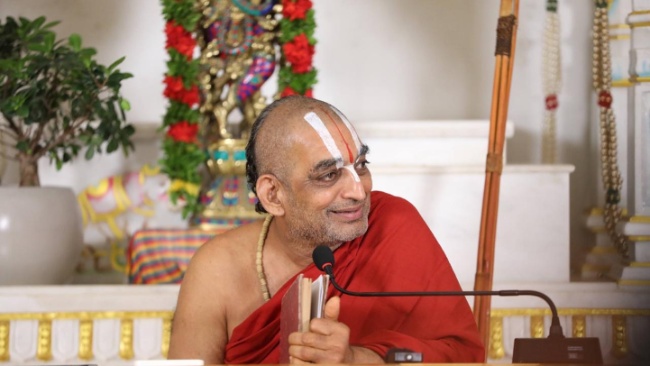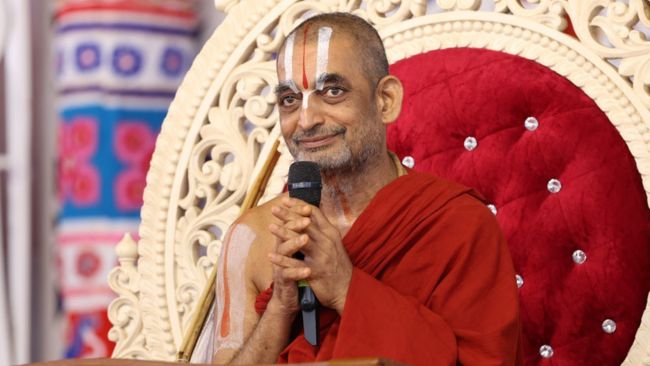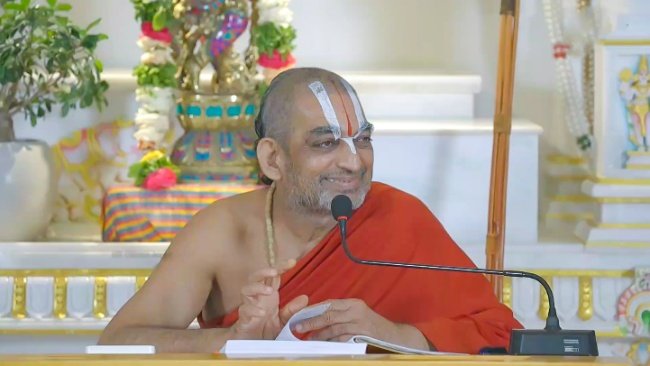
Ashtadasa Rahasyas – 18 Secrets
It’s not always the letters and words alone that carry meaning — often, the comprehensive essence can only be found when one understands what is hidden between the letters of the words, and between the words of the sentences.
We experience this subtlety in our daily lives too.


In much the same way, only the Lord Himself—and the revered Elders—can reveal the profound depths hidden within the Vedic literature and the mantras that carry its essence.
Pillai Lokacharya Swami took upon himself this noble responsibility and presented the profound insights of Vedas in the form of eighteen foundational texts or discourses.
| Yaadrucchikapadi |
A concise text offering a brief explanation of the three principal mantras. However, it was later felt that the brevity limited its clarity and depth — which led to the next composition.
| Parandapadi |
A more elaborate and detailed exposition on the same three principal mantras. Yet, its extensive nature risked overwhelming the reader, obscuring the core message — prompting the creation of the next text.
| Sriyahpathipadi |
A medium-length text that presents the same teachings with greater clarity. However, its extensive use of Sanskrit terminology made it less accessible to the common seeker — leading to the final refinement.
| Mumukshupadi |
A balanced and comprehensive work on the three principal mantras. Free from the limitations of the earlier texts, it is neither too brief nor overly detailed, and uses minimal Sanskrit — making it more approachable for a wider audience.
| Thanipranavam |
A text devoted exclusively to Pranavam — the sacred syllable Om (Omkaram). It explores its profound significance, particularly as the essence of the Thirumantram (the Ashtakshari mantra). The text elaborates on svarupa yaadaarthyam — the true nature of the self, the Supreme, and the relationship between the two.
| Thanidvayam |
A focused exposition on the the Dvaya Mantra, offering deep insights of the state of moksham, a soul’s ultimate and natural state of liberation and joy.
| Thanicharamam |
Centered on the Charama Shloka, this text explains how one should live after realizing the truths of the self, the Supreme, their relationship, and the goal of moksha.
(Note: “Thani” denotes that it is focused on the subject.)
| Artha Panchakam |
A text that encompasses the essence of all sasthras ie. addressing the five fundamental questions every soul must contemplate and learn about:
- Who is the Supreme?
- Who am I?
- What is my ultimate goal?
- What are the obstacles in reaching that goal?
- What is the means to attain it?
| Thatthva Thrayam |
A text that elaborates on the three eternal realities (tattvas). The word tattvam refers to “that which truly exists in order”—the fundamental principles that underlie all of existence.
- Prakriuhi(Nature) – the material substance from which all bodies are formed—whether animals, birds, mountains, rivers, or anything visible around us. Prakriti consists of 24 elements and forms the first eternal reality.
- Athmas (Souls) – the individual souls that give life to the bodies that they indwell. Countless such souls exist, making this the second eternal reality.
- Because a soul enlivens the body, it is called jiva—“ji:vayathi iti ji:va” (that which gives life).
- Because it dwells within and governs the body, it is also called atma—“a:pno:thi ithi a:thma” (that which permeates and governs).
- Paramathma (Supreme Soul) – the ultimate controller, Bhagavan. The individual souls are not independent; they do not decide how long they remain in a body or when they depart. All such transitions happen according to a divine order governed by Paramatma, making Him the third eternal reality.
| Thatthva Sekharam |
A text that explains reasons why understanding these three realities is essential, and explores two reasons we often fail to perceive them clearly.
| Navavidha Sambandham |
A profound exposition on the nine eternal relationships every soul shares with God, this text reminds us of the true purpose of knowledge.
While we often identify with the body and get absorbed in the temporary relationships built around it, we lose sight of our most enduring bond—with the Lord. It’s like becoming emotionally attached to a vehicle provided by a manager, while forgetting the purpose for which it was given. Similarly, we grow attached to this body—merely an instrument—forgetting that it was meant to help us reach Him.
Even when we recognize God as the Supreme, we often approach Him seeking favors tied to bodily desires and worldly goals. In doing so, we turn in the opposite direction—using what was meant for liberation to seek more entanglement.
| Prameya Sekharam |
A beautiful text that describes what happens after we learn the above – it is the blissful journey of the soul of 64 steps. Prama means knowledge; Prameya is that which must be known in order to attain true knowledge.
| Archiraadi |
A companion text that presents the same post-liberation journey in even greater clarity and detail.
| Prapanna Parithraanam |
A text that explains why we are not yet ready to embark on that blissful, liberated journey called archiraadi, and how that pushes us to who we are and who our protector is
- Akinchanyathvam – recognizing the depth of our sinful, pitiable condition
- Ananya Gathitvam – realizing that the Supreme Soul, Bhagavan, is our only refuge and the sole means of moksha – the final liberation that involves charama karma dhvamsam (the completion of final residual karma) followed by bhagavath kainkarya prapthi nyrantharyam (eternal, uninterrupted divine service to the Lord)
| Saara Sangraham |
A powerful text affirming that the teachings presented in the above works are not inventions, but divine revelations passed on by great jnanis. They were revealed by the rishis and Alwars. This text summarizes Nammalwar’s 1000 verses (Tiruvaymozhi) by dividing them into ten sets of 100 and providing the essence of each set, making it accessible for all seekers.
| Samsaara Saamraajyam |
A compelling exposition on samsara — ego; identity built around the body because this is the reason for not being able to attain that great knowledge. This text is presented in a beautiful metaphoric way describing how we falsely assume bodily existence and relationships to be ultimate, digging ourselves into a pit of ignorance.
| Sri Vachana Bhushanam |
A revered compilation of enlightening discussions held between great souls, our purvacharyas – acharyas in lineage, at different times in different situations. These dialogues, although not aimed at directly teaching us, though at times appearing like debates or challenges or ‘casual’-talk, are rooted in compassion and serve the singular goal of guiding seekers to the correct knowledge and path. If these are understood and remembered, it is said that you are adorned with a great ‘gem studded chain’ on your neck.
| Navaratna Maala |
Another treasured compilation of such profound conversations and teachings, shared among the great Acharyas and scholars of the tradition.
Pillai Lokacharya Swami (13th century – graced 105 years on this earth) took a revolutionary step by breaking the language barrier, presenting the profound Vedantha truths in a local language so they could reach a broader audience. In the following century, Manavala Mahamuni (14th century) provided authoritative commentaries on three of the eighteen texts—Mumukshuppadi, Tattva Trayam, and Sri Vachana Bhushanam—firmly anchoring them in Vedic tradition by referencing the pramanas, the Vedic literature.

– From the teachings of HH Chinna Jeeyar Swamiji
Mumukshuppadi,19th Aug 2025
– JIVA asram, Sri Ramnagar, Hyderabad, TS, India





this app is very useful and reaching common people and knowing lord and self ..
thankful to chinna jeeyar swamiji
this modern world needs this knowledge and this needs to be continued
so world be at peace
Jaisrimannarayana 🙏🙏🙏🙏🙏🙏🙏🙏